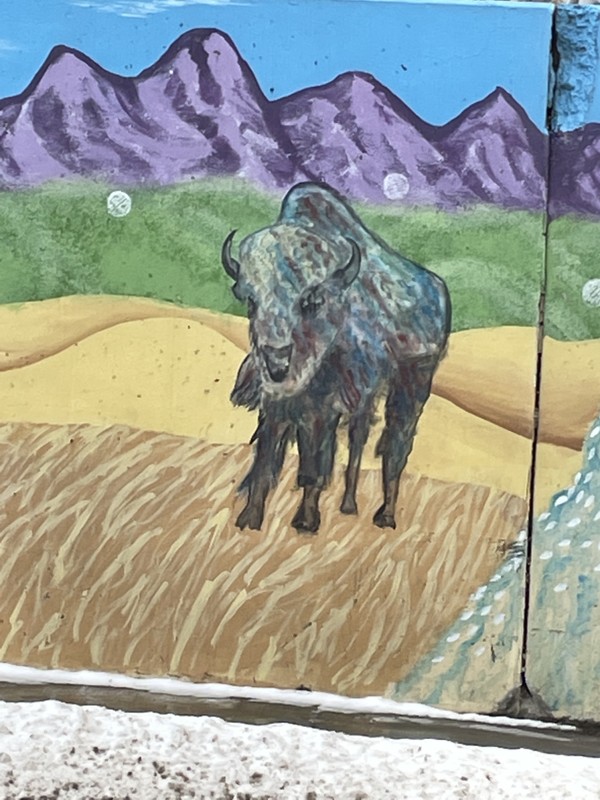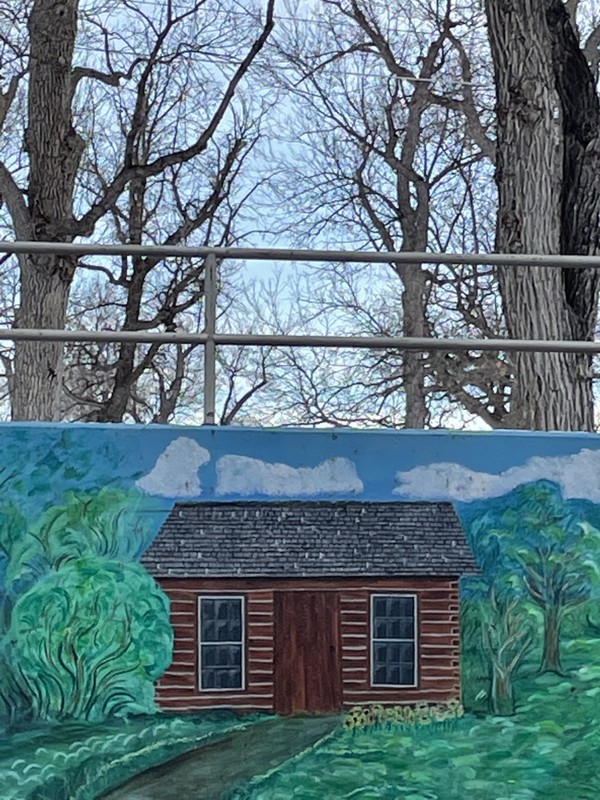First Avenue North Underpass Southside Mural
Introduction
Text-to-speech Audio
For the Great Falls Downtown Mural Walking Tour, park in the City Parking Lots accessible from River Drive South, near the Water Park at 100 River Drive South. Walk to First Avenue North to see the first mural.
To start the Great Falls Downtonw Murals Walking Tour, park in the City Parking Lots accessible from River Drive South, near the Water Park at 100 River Dirve South. Walk to First Avenue North to see the first mural
On the south side of the First Avenue North underpass (where the road goes under the railroad tracks) is the "Buffalo/Bubbalo" mural, depicting the history of Great Falls by various artists who drew images depicting Great Falls in a buffalo. In 2012, the Great Falls Business Improvement District (BID) went public with a Call to Artists to seek mural designs for this location. The underpass had previously been home to a mural that had been done as an Eagle Scout project that was approaching 20 years of age. As a location frequently targeted by graffiti, the BID, knowing that murals are a graffiti deterrent, decided to fund the installation of new artwork. The art selection committee, led by the BID, chose CMR High School senior Kelsey Staigmiller’s design. Her design depicts a cowgirl on the prairie blowing bubbles, as the bubbles blow away from her they morph into buffalo. This depiction of the plains filled with buffalo reflects the history of the area surrounding Great Falls. Five artists were employed by the BID in the summer of 2012 to install the mural you see depicted here. Look carefully at each buffalo to get a feel for the history of Great Falls. The mural is in the midst of the Great Falls Historic Railroad District, so named because of historic buildings and other structures which are important contributions to Great Falls history.
Images
Bison -- Bubbles Mural

Painting of Vinegar Jones Cabin, 1st building in Great Falls.

Backstory and Context
Text-to-speech Audio
Great Falls founder Paris Gibson envisioned his young city becoming both “a great industrial center” and “a city of unsurpassed beauty.” These twin goals converged in the Railroad Historic District. Like other “City Beautiful” advocates, Gibson believed that parks could help promote civic virtue. They were also good for business. Beauty, according to Gibson, would attract growth. Even more essential to growth, however, were railroads, and in 1887, the city welcomed the Great Northern’s decision to lay its tracks through Gibson’s original Cascade Park Reserve. Soon hydroelectricity from Black Eagle Dam powered large smelters, built to refine the silver and copper ore delivered by rail. The 1890 stone Arvon Block remains a legacy of the city’s first boom. Construction slowed after the Panic of 1893 only to rebound in force when the 1909 Enlarged Homestead Act brought an influx of settlers to the region. The railroad most closely associated with homesteading in Montana—the Chicago, Milwaukee and St. Paul—arrived in Great Falls in 1910. To accommodate the line, the city ceded a right-of-way through Riverside Park and required the removal of businesses in the railroad’s path. The years that followed saw construction of numerous commercial blocks, warehouses, and railroad-related buildings, many designed by the city’s leading architects. The railroads’ rival passenger depots are the era’s best-known landmarks. Private construction slowed after 1929. To create jobs during the Great Depression, the federal Works Progress Administration invested in park improvements, road and bridge repairs, and new construction, including the monumental Civic Center, built in 1939.
Sources
Great Falls Historic Railroad District Walking Tour
https://greatfallsmt.net/planning/railroad-historic-district-walking-tour
Various Artists
Joan Redeen, Business Improvment District, April 2022.
